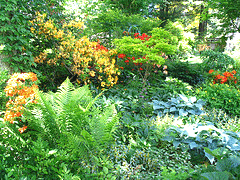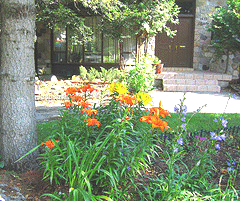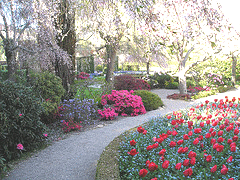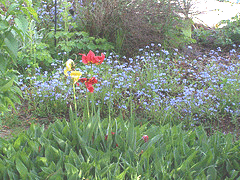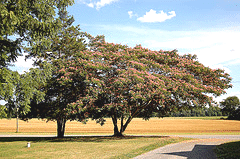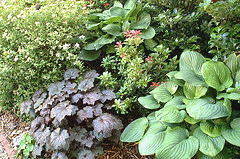Designing with Plants & Color
Planning the design of your garden’s plants and color is where you get to be an artist! Even if you don’t think you’re very artistic, just have some fun and do what you love.
There are so many plants to choose from it may seem difficult to narrow down the choices. Let site conditions whittle the list down first. Sun and soil conditions have already been mentioned as the most important factor in plant selection. If you live in a high elevation, some plants thrive better than others, your local garden centers and University Extension services may be your best source of information about altitude. From there, consider the micro-climates that exist throughout the property. Certain areas will be warm in spring and hot in summer if they are exposed to all day sun, requiring heat tolerant plants or perhaps extra watering. That same area may be exposed to harsh winter winds because of it’s open location, so select something hardy enough to hold up. Summer winds can also be damaging to some plants, so any exposed are will require plants that tolerate wind. Select drought tolerant plants for areas that will not receive much supplemental watering. Areas that are perpetually wet will literally rot the roots of some plants, look for those that will thrive in moist soil. For large planting areas with moderate conditions, you still may want to select plants with similar needs. A bed of drought tolerant plants will require very little, or no supplemental watering. Adding just one plant requiring regular watering will demand that you get out there and water the bed. Plants that require heavy fertilization can be grouped together.
Think about how much maintenance time you are willing to commit to your landscape. If you have very busy weekdays and prefer to relax on the weekends, make sure you select plants that do not require frequent pruning, watering, fertilizing and deadheading. Look for plants that are disease and insect resistant. Native plants are often the most tolerant of your local conditions, and resistant to problems. Reserve your maintenance time for just a few special plants you love that require extra care. And mulch heavily to minimize weeds, 3-4 inches deep.
A trip to the nursery center may help you make some of the plant selections. Discussion with knowledgeable employees can give you some guidance, and knowledgeable shoppers are often full of advice and tips for you. So strike up conversations! Physically viewing plants will also give you a better idea of the form, texture and foliage color. It is tempting to make your decisions at the nursery, but your first trip should be devoted to gathering information about the characteristics, noting growth rates and mature size. Remember that a plant recommended for full to part sun may not grow as quickly or as large in part sun as it will in full sun. Soil conditions that are not favorable to the plant will also limit it’s growth potential. Check on the changes of plants from spring to summer to fall, especially if you are also coordinating season long interest in your gardens. This is a lot of information to remember or take notes on, if you have a compact voice recorder you will be able compile tons of information quickly and easily.
Color and texture will be very important to the overall design of your landscape and gardens. Remember that color doesn’t apply just to blooms, but to the foliage. And texture can apply to blooms as easily as foliage. People may give you a lot of advice about color use, but color preference is very personal. Especially for blooming plants, choose a color, colors or family of colors that YOU love. Don’t be surprised if those preferences start to change as you browse, select and grow your gardens over time. You are allowed to change your mind as much as you want. Experimenting and changing your gardens is half the fun of gardening. Consider all the possibilities of using color and texture.
Reds, orange and yellow are hot colors that draw attention. They can be used in small doses as an accent or to draw attention to a more subtle element of the landscape. Hot colors are easily noticed at a great distance, so work great for the far corners. Or if you just love the colors and their hot tropical look go ahead and use one as a dominant color in your design, or use the whole family throughout. Soften and balance a hot color scheme with neutrals and complimentary colors. Complimentary colors are directly across from each other on the color wheel, but that is very simplistic. Colors are also complimentary in design as you move slightly away from the direct compliment. They work well together and contrast each other. Evergreens, particularly those in a more blue green tone, are an excellent backdrop for hot orange and red. Red blooms work beautifully with blue blooms, orange and yellow blooms with blue or purple.
A cool color scheme uses the receding colors of green, blues and purples. A cool color scheme creates a more relaxing, quiet area. Cool colors of course are accented well with hot colors. But if your objective is to create a calm area, blend in white and silver-gray neutrals.
A monochromatic color scheme can be designed either cool or hot. It can also be done cool with hot accents, or hot with cool accents. Monochromatic is simply the use of one color in tints (color hue deepened) and shades (color hue lightened). A variety of blues from pastel to deep, or blues leaning or including purple are both monochromatic. Reds and oranges or orange and yellows used together create a monochromatic scheme. Once you expand very closely related colors a little further to, for example, red, orange and yellow, your color scheme has become analogous. A triadic color scheme is also very high energy, in a little different way than hot colors are. Triadic is the use of three colors evenly separated on a color wheel. The three primary colors, red, blue and yellow, are triadic. The use of primary colors can create a simple and vivid color scheme for a garden. The secondary colors, purple, orange and green are also triadic. This creates a very striking color scheme. The point is, nearly all colors work well together in nature. Nature itself provides a calming, balancing, and neutralizing backdrop of greens and browns for your landscape. A color wheel and color principles can help you make some decisions, but you can probably find a color design principle that supports using the colors you love.
Use pastels - cream, pale pinks an yellows, lavender - for a soothing effect. Pastels are wonderful for a sitting area just outside the house, where you might go for a brief “breather” after a long day at work. If you feel a pastel color scheme needs a little “jazzing” up, accent with one of the colors in a deeper or brighter tone.
White helps to transition between colors. You may want to use more than one color scheme in your garden areas and the colors may not work well together. White bloom, and creamy, grayed or silvery greens can be used as buffers between your colors. These neutrals, including dark colored foliage, also work well as background for bright colors. And neutral colored plants with interesting textures work well to add depth and interest at the front of the borders.
Use drifts to make a statement. Drifts of a single color can be very dramatic. A drift is a relatively large, irregular sweep of a single color or plant. Plant them in wide sweeps of odd numbers, creating a natural looking flow. Drifts can be modified smaller, groups of 3 or 5, for smaller garden areas, and drifts can flow together, joined irregularly. A drift of any size is easier to comprehend than a garden filled with many single plants.
The final part of color design, is developing a plan that will display color when you want it most. If you spend a lot of time at the cabin in the summer, your color display should be focused on spring and fall, utilizing low maintenance plants that will survive neglect when you are away. If you have a pool, your focus may be on the height of summer when you are entertaining and lounging. Most of us long for overflowing displays of blooms from spring to frost. Unfortunately, most plants including annuals, do not bloom for such a long period. So we need to plan for interesting display throughout the gardens at various times of the season. Bulbs that bloom very early, early and late spring, summer blooming bulbs, and fall bulbs, can be tucked in anywhere and everywhere to fill in between bloom periods of your perennials and shrubs. Bulbs should be planned last since they will fit nearly anywhere, even in a very crowded bed. Azaleas, Rhododendrons, Forsythia and lilacs are early bloomers, generally followed by peonies, iris and alliums. But bloom periods for your area and specific varieties can vary quite a bit, so be sure to check. Various flowering perennials bloom for a couple to a few weeks throughout the summer, and annuals are generally at their peak in mid to late summer. Certain varieties of roses may bloom throughout the summer. Cannas bring a bright new display to the gardens in late summer, followed by fall asters and chrysanthemums.
Colored foliage can brighten the landscape and add interest all season. Evergreens of emerald, blue-green or golden supply color and texture even through winter. Certain deciduous shrubs can add a variety of color in large doses. Purple leaf plum is a great purple-maroon backdrop for white, creams and pastels. Daphne, variegated dogwood, and Japanese willow are wonderfully variegated. Heuchera is available in a wide variety of colors from bright greens to deep maroon-purple. Several perennials are grown specifically for their interesting and colorful foliage, blooming may be insignificant. Caladium and Coleus are full of color, from chartreuse to bold fuscia, and are often variegated and textured. Also for the shade hosta varieties, textures and colors are seamingly endless. Lamiums and pulmonaria have interesting speckled spotted or crackled foliage.
In addition to color, the growing habits of plants can play a large part in your design. Both shrubs and trees typically have a distinct natural habit or form. Generally they will grow in a rounded, oval, pyramid or columnar form. The pyramid and columnar forms of shrubs can lend the illusion of height, without necessarily being very tall. Tall trees of course give you substantial height, but the habit of the foliage can be casual in a broad oval, or rounded. Pyramid shaped foliage can appear a bit more formal. A substantial departure from these forms is a weeping habit. These can be specimen trees, ornamentals or focal points. Certain evergreens form a pendulous, weeping or cascading form, from 1 1/2 feet high to towering evergreens. Weeping cherry and weeping crab are deciduous and flowering. Pagoda dogwood trees and Hawthorne are ornamental trees with a horizontal branching habit. Branches of the Bridalwreath spirea arch gracefully.
And finally, although touched on briefly already, texture is everywhere in a plant. We typically think of texture in coarse leaves, but even then ordinary smooth leaf has a texture of smooth. Texture is found in the foliage, bark, and blooms. Texture can be smooth, rough, wrinkled, feathery, or fine. Liberal use of fine textures in a small garden can make the garden appear larger, strong coarse textures can make it appear smaller. Textural contrasts add interest and excitement to the landscape



